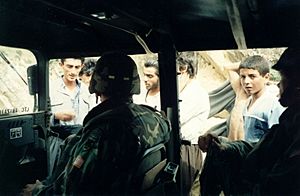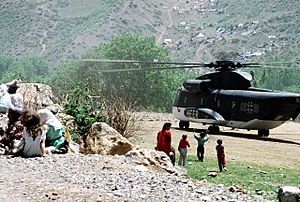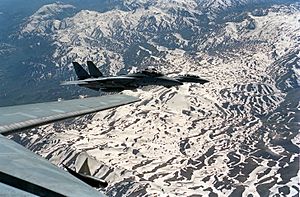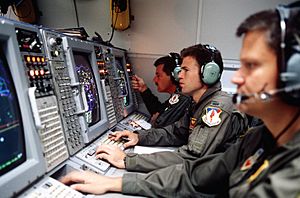Operation Provide Comfort facts for kids
Quick facts for kids Operation Provide Comfort/Provide Comfort II |
|||||||
|---|---|---|---|---|---|---|---|
| Part of the Iraqi no-fly zones conflict | |||||||
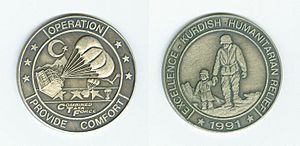 Commemorative medallion issued to some participating US soldiers |
|||||||
|
|||||||
| Belligerents | |||||||
Support: |
|||||||
| Commanders and leaders | |||||||
| Casualties and losses | |||||||
|
2 UH-60 Black Hawk helicopters downed by friendly fire with 26 killed |
90 killed, 85 wounded Many air defense systems destroyed 1 MiG-23 Flogger shot down 1-2 Su-22 Fitters shot down |
||||||
Operation Provide Comfort and Provide Comfort II were important military operations. They were started by the United States and other countries that had fought in the Gulf War. These operations began in April 1991. Their main goal was to protect Kurdish refugees who were running from their homes in northern Iraq. This happened after the Gulf War. The operations also aimed to deliver humanitarian aid to these people. A special "no-fly zone" was set up to help. This zone became a key reason why the Kurdistan Region was able to become a self-governing area.
Contents
Helping Kurdish Refugees
The United Kingdom called this mission "Operation Haven." It was a UK-led effort. At first, the US was not very interested in taking more action in the Persian Gulf. But the UK Prime Minister convinced other European countries. This led to NATO's support, which brought in the needed US air support.
As Saddam Hussein's actions against the Kurds grew worse, the US also provided ground and logistical help. Still, it was mainly a UK-led operation. They planned for 6,000 military personnel. The main forces were the 3 Commando Brigade of the Royal Marines, along with parts of the UK army and Royal Air Force. Other countries also sent forces.
The mission was very successful, even though it seemed risky at the time. Operation Haven involved entering Iraq. The main goal for the Coalition forces was to go into northern Iraq. They needed to remove any Iraqi threats. Then, they would create a safe area for Kurdish refugees to return home.
This mission was both military and humanitarian. Once the area was safe, the US provided air support and special teams. Other Coalition members helped too. They supplied aid and started rebuilding damaged areas. The ground mission inside Iraq lasted 58 days. Operation Provide Comfort (or Haven) officially ended on July 24, 1991. After that, the "No Fly Zone" continued to keep the Kurds safe.
US Involvement and Key Events
In 1991, an uprising in northern Iraq led to a strong response from the Iraqi military. Millions of Kurds feared another genocide, like what happened in 1988. They fled towards the borders of Iran and Turkey.
On March 3, General Norman Schwarzkopf warned Iraq. He said Coalition aircraft would shoot down Iraqi military planes flying over the country. On March 20, a US F-15C Eagle jet shot down an Iraqi Su-22 Fitter over northern Iraq. Two days later, another F-15 destroyed a second Su-22. An Iraqi pilot also bailed out after being approached by US fighter planes.
On April 5, the United Nations Security Council passed Resolution 688. This resolution asked Iraq to stop harming its own people. On April 6, Operation Provide Comfort began. Its goal was to bring humanitarian help to the Kurds.
A no-fly zone was set up north of the 36th parallel. This was done by the US, UK, and France. It was part of the larger Iraqi no-fly zones. Aircraft from these countries enforced the zone. This effort included a huge airlift. It delivered humanitarian aid to over 1 million Kurdish refugees. Six nations took part in this airlift from Incirlik Air Base in Turkey. These nations were the US, UK, France, Germany, Canada, and Italy. Even Soviet aircraft helped with transporting supplies.
The airlift was commanded by Colonel Dave Wall. During the 31-day airlift, more supplies were delivered and more miles flown than in the entire Berlin Airlift. C-130s and other transport planes dropped supplies from the air. A-10s and F-16s provided air and ground support for these planes. Sometimes, A-10s even disabled Iraqi radar units.
Units from the 18th Military Police Brigade helped keep things safe. They guarded the headquarters, Kurdish refugee camps, and convoys. This brigade was the last unit to leave the area.
Operation Provide Comfort was managed by the US European Command (EUCOM). This was different from the Gulf War operations, which were run by US Central Command. Humanitarian aid on the ground was provided by the 353rd Civil Affairs Command. These units helped in Kuwait before moving to Turkey and northern Iraq. They were joined by the 96th Civil Affairs Battalion.
Camps were built for Kurdish refugees. Some were named Camp Jayhawk and Camp Badger, after college mascots. Other camps were in Silopi, Turkey. The first troops to arrive were from the 36th Civil Engineering Squadron. Smaller camps were also built in Zakho, Iraq and Sirsenk, Iraq. Supplies for these camps came from many places. Many supplies had to be air-dropped because Turkey limited ground access into Iraq.
The Naval Mobile Construction Battalion 133 also helped in Zakho. They provided humanitarian aid, dug water wells, and made small repairs to Sirsink airfield. This was the first time this type of Naval unit entered Iraq before Operation Iraqi Freedom. Carrier Strike Group 6 also provided air power and intelligence support. Its planes flew over 900 missions over Iraq.
Lieutenant General John Shalikashvili was in charge of the entire operation. He later became the highest-ranking military officer in the US. Major General Jay Garner commanded the multinational ground forces. He later became a special representative to Iraq.
The first regular US troops to enter Zakho were Marines on April 20, 1991. About 300 Iraqi Army soldiers were still there, pretending to be police. US Special Forces had entered Iraq a week earlier. The 24th Marine Expeditionary Unit (MEU) was about 2,000 Marines strong. They were joined by 697 Royal Marines from 45 Commando and 400 Dutch Marines. Their job was to contain Zakho until Iraqi forces left.
Many countries sent military forces to help. In total, 20,000 military personnel from 10 countries took part. The Kurds stayed in camps like Jayhawk and Badger.
The US contributed to the operation, but the United Kingdom led the initiative. The UK provided significant ground and air forces, including the 3 Commando Brigade. France, the Netherlands, and Australia also helped. The UK sent 40 and 45 Commando Royal Marines and transport planes. France sent transport aircraft and special forces. The Netherlands sent troops and a medical/engineering battalion. Australia sent transport aircraft and medical teams.
There was an incident in March 1991 at a refugee camp in Yeşilova, Turkey. Turkish soldiers were accused of taking supplies meant for refugees. The Corps of Royal Marines had to step in to help distribute aid.
Operation Provide Comfort II
Operation Provide Comfort II started on July 24, 1991, the same day Provide Comfort ended. This second operation was mainly military. Its mission was to stop Iraq from attacking the Kurds.
Because Western countries supported the Kurds, Iraqi troops left the Kurdish regions in October 1991. These areas then became independent in practice.
On April 5, 1992, Iran's air force bombed bases in northern Iraq. These bases belonged to a Kurdish group. Iraqi jets tried to stop the Iranian planes, but Coalition aircraft did not get involved.
In January 1993, Iraqi air defense sites fired at two US F-111 bombers. Later, Iraqi Su-22s fired at two F-16 jets. A US F-4 Phantom then destroyed an Iraqi radar that was targeting French planes. About 30 minutes later, a US F-16 shot down an Iraqi MiG-23 Flogger that had flown into the no-fly zone. The next day, US F-16s bombed an airfield. F-4 Phantoms attacked Iraqi air defense sites. Over the next few months, more Iraqi sites fired at American patrols, and several were attacked. In August, US F-15E Strike Eagle aircraft dropped bombs on an Iraqi missile site.
On April 14, 1994, two US F-15 Eagle fighters on patrol accidentally shot down two US Army Black Hawk helicopters. These helicopters were carrying 26 Coalition people, and everyone on board was killed.
On December 9, 1995, F-4 Phantom II aircraft finished their duty with the task force. This was the last time the F-4 Phantom was used in operations by the US Air Force.
In August 1996, Iraqi troops entered the Kurdish regions of Iraq. The United States responded with Operation Desert Strike against targets in southern Iraq. Some incidents happened in northern Iraq. The US then launched an operation to help pro-American Kurds leave northern Iraq.
Operation Provide Comfort II officially ended on December 31, 1996. This was at the request of the Turkish government, who wanted to improve relations with Iran and Iraq. The operation was followed by Operation Northern Watch. This new operation began on January 1, 1997. Its mission was to keep enforcing the northern no-fly zone. France chose not to participate in Operation Northern Watch.
See also
 In Spanish: Operación Proporcionar Confort para niños
In Spanish: Operación Proporcionar Confort para niños


